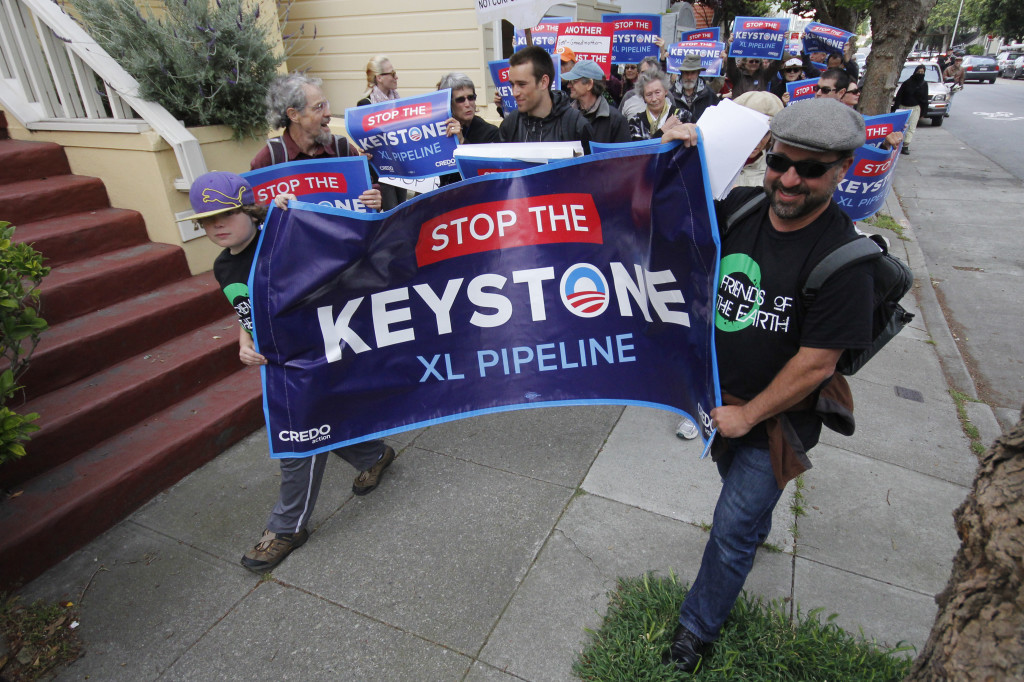Environmentalists and big corporations are butting heads yet again on the issue of the Keystone Pipeline. The final Environmental Impact Statement for the pipeline was released by the State Department at the end of January. The statement claimed that the pipeline won’t have much of an impact on climate change. Tar sands oil, the report said, will continue to be extracted regardless of the construction of the pipeline—meaning the environmental impacts are allegedly minimal. But environmentalists across the country have criticized TransCanada for taking steps that could have disastrous consequences, not only on the environment, but also on the lives of people everywhere. Seattle University students agree.

Protesters gather and march from San Francisco’s Alta Plaza Park to demonstrate against the Keystone Pipeline during President Barack Obama’s visit to the city.
“The vast majority of these effects will harm the poorest who contributed the least to this dilemma,” said Ames Fowler, a student and a member of the Sustainable Student Action Club. “For these reasons, furthering any fossil fuel extraction, especially those dirtiest fuels like the oil sands, is morally objectionable.” The continuous extraction of crude oil could have a catastrophic impact on the climate, he said. One could even witness a rise in the oceans, temperatures going up which could cause an upheaval in the ecosystem thereby causing droughts and famines. The current Keystone Pipeline runs from the oil sand fields of Alberta, Canada into Cushing, OK. The new proposal suggests a pipeline running from Hardisty, Alberta to Steele City, Nebraska. Also known as the southern leg or the Phase Three of this project already went into operation in at the beginning of this year, and as a result brings in 700,000 barrels of tar sands oil into Texas, according to an article in the Washington Post. If this proposal is accepted, a total of 830,000 barrels of crude oil could be seen entering America, the article said. The pipeline would impact the states of Texas, Nebraska, Oklahoma, Montana, Kansas and South Dakota. “This is America’s agricultural heartland, as well as the location of major U.S. rivers and aquifers that directly affect agriculture and wildlife,” said Seattle U student Ashlan Runyan, a member of the Sustainable Student Action Club. She explained that contamination will take place due to waste water leeching which is a direct consequence of extracting oil from tar sands. This in turn would affect the nation’s water supply thereby affecting agriculture and food supply, she said. Tar sand extraction would also lead to increased deforestation. Saying yes to this proposal would see an increase in the emission of greenhouse gases by 17 percent, according to Lincoln, Nebraska’s online newspaper Journal Star. However, saying no to the pipeline would mean that the oil would be transported via ships and trains, thereby increasing the emission of greenhouses gases to 28 percent, Journal Star reported. Pipelines also increase the risk of oil spills, Fowler said. “I fear that there may also be immediate loss, personally and economically to any region that is spilled upon,” Fowler said. “Moreover, we know that at some point fossil fuels will have to stay in the ground if we are to avoid the worst of the climate crisis.” The proponents of this proposal say the pipeline would create new jobs and
would allow American and Canadian oil producers to have more access to the oil refining markets in the American Gulf Coast and the American Midwest, thereby encouraging the oil market in both countries. Such a pipeline would also mean an oil independent North America. The Washington Post reported that the pipeline would create a total of about 1,950 jobs for a couple of years throughout Montana, Kansas, Nebraska and South Dakota. But students wonder, is it worth it? Runyan pointed out that the rejection of this pipeline proposal would once and for all make the statement that as a nation the United States will not be dependent on fossil fuels. “Of course, as a student at Seattle University, it is imperative that we consider the environmental effects and what it means in light of the future,” she said. “The pipeline is capable of carrying 1.1 million barrels per day which is an alarming statistic. Oil from the tar sands emits 17 percent more carbon dioxide than the average barrel of crude (according to the State Department) which directly relates to climate change. Once we start building the pipeline, what is to stop the continued expansion of oil sands?”








